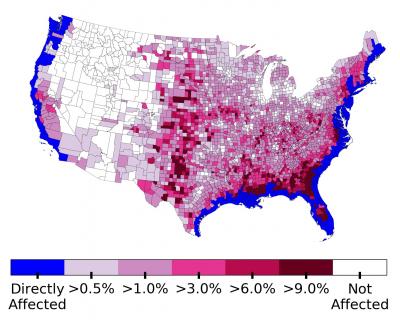Sea Level Rise Could Force 13 Million in the U.S. to Relocate
Around 13 million people could be forced inland in the U.S. due to the rising sea levels expected by 2100, according to a new study led by University of Southern California's Professor Bistra Dilkina.
The study is the first to use machine learning to project migration patterns resulting from sea-level rise.
The most popular relocation choices are expected to be land-locked cities such as Atlanta, Houston, Dallas, Denver and Las Vegas. The study also predicts suburban and rural areas in the Midwest will experience a disproportionately large influx of people relative to their smaller local populations.
To predict the trajectory of sea-level rise migration, the researchers took existing projections of rising sea levels and combined this with population projections. Based on migration patterns after Hurricane Katrina and Hurricane Rita, the team trained machine learning models - a subset of artificial intelligence - to predict where people would relocate.
As expected, the researchers found the greatest effects of sea-level rise migration will be felt by inland areas immediately adjacent to the coast, as well as urban areas in the southeast U.S. But their model also showed more incoming migrants to Houston and Dallas than previous studies, which flagged Austin as the top destination for climate migrants from the southeastern coast.
The effects could include more competition for jobs, increased housing prices and more pressure on infrastructure networks.
"Sea level rise will affect every county in the U.S., including inland areas," said Dilkina. "Our findings indicate that everybody should care about sea-level rise, whether they live on the coast or not. This is a global impact issue."
Sea-level rise is caused primarily by two factors related to global warming: added water from melting ice sheets and glaciers and the expansion of sea water as it warms. Within just a few decades, hundreds of thousands homes on the U.S. coast could be flooded, says Dilkina. By the end of the century, six feet of ocean-level rise would redraw the coastline of southern Florida, parts of North Carolina and Virginia and most of Boston and New Orleans.

Number of additional incoming migrants in the 1.8 meter sea-level rise scenario (versus a business-as-usual scenario) per county as a percentage of that county's population. Credit: Bistra Dilkina and Caleb Robinson.
